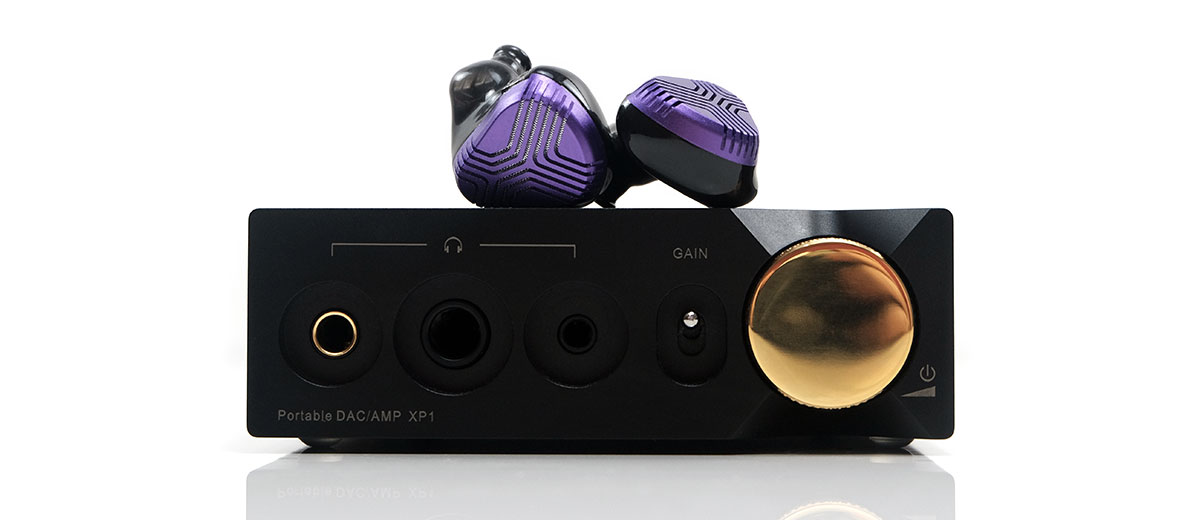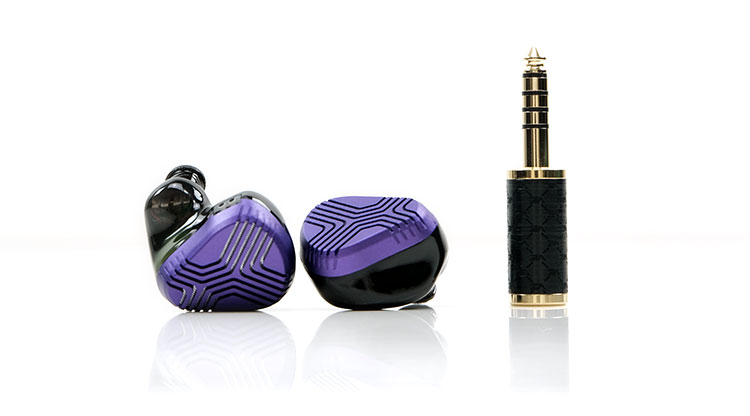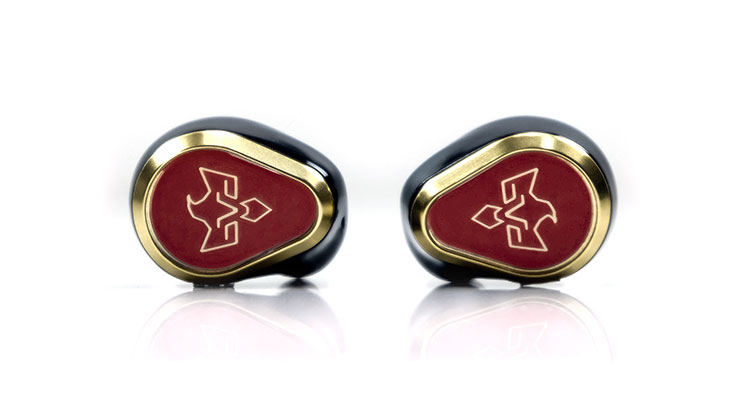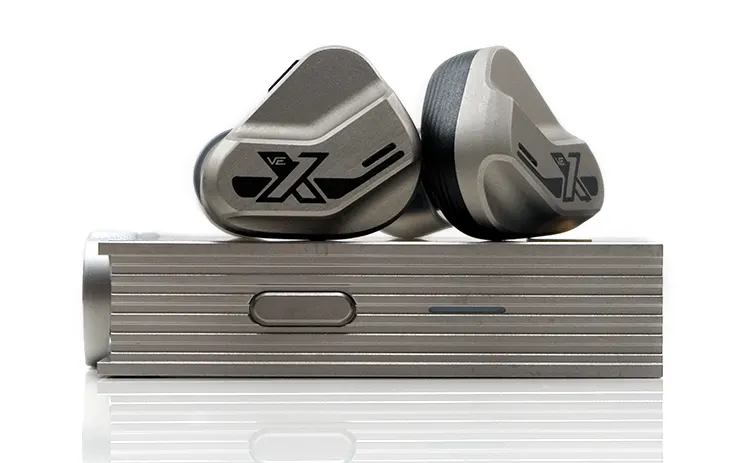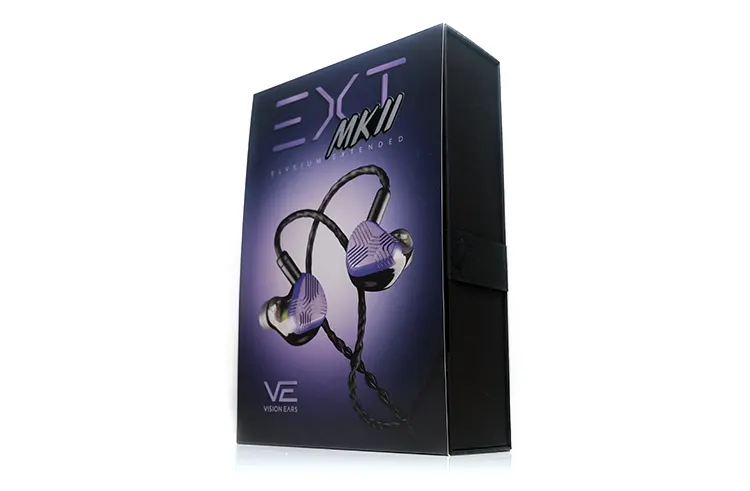Select Comparisons
The following select comparisons to the Vision Ears EXT MKII were completed using a mix of iBasso’s DX320 MAX Ti, the Cayin RU7, and the Shanling ONIX Mystic XP1. All three were connected in balanced mode with the stock SpinFit CP145 ear tips fitted to the EXT II.
Vision Ears EXT
The Vision Ears EXT was launched in late 2021, almost exactly three years ago, and was our Co-Awardee for our Top Gear Best Universal IEM award for the same year.
Technical
On paper, there is very little difference between the EXT MKII and the original EXT.
They both use dual 9.2mm and 6mm dynamic with Liquid Silicone Rubber (LSR) surrounds for the lows and the mids and a quad EST driver configuration for the highs and ultra-highs with a 3-way crossover.
They are rated the same 10Ω and 108 dB/mW @1kHz impedance and SPL, and both use the HALC midrange driver and STC or side tuning chamber acoustic chamber design.
The key difference is the redesign of the 9.2mm dynamic driver for the lows, which changes the performance markedly between the two, as you will see in more detail below. Oliver has also re-tuned the EST drivers, so it’s not a like-for-like in the highs, either.
The other important change was the nozzle size, primarily for comfort, but it also meant the VE team had to change the internal horn and tubing arrangement to accommodate it.
Design
You can also get the EXT MKII in the purple cyberpunk theme of the original EXT.
If you have the original, this might not be the most advisable thing to do unless you love purple above all other colors. Thankfully, Vision Ears has seen fit to release a second grey color, which, from the pictures, looks nice. However, if you must have one EXT only, then the EXT MKII in purple is the snazzy-looking design.
The form factor is almost the same. Both IEMs are wonderfully compact and fit flush in your ear thanks to the unique perpendicular nozzle shape that brings the main shells very close to the concha basin of your ear.
The smaller nozzle on the EXT MKII should be the difference maker for those complaining about comfort and tip changing on the original model. It is now comfier and easier to tip roll quickly.
I still enjoy the fitting of the original but I have wide ear canals so this is anecdotal feedback. I did hate changing the tips though and have the CP145 stock tips on them for 3 years.
It is perhaps ironic that I will stick with the SpinFit tips for the EXT MKII as they have a slight edge in comfort over the Crystal Tips and deliver a more natural warmer sound.
Aside from the new default 4.4mm plug jack, everything else, the accessories to the general packaging layout and carry case, is unchanged from the EXT.
Performance
The most obvious change here is the bass shelf which is more elevated on the original by around 2-4 dB between 20Hz to around 500Hz just as you hit the lower mids.
The shape of the EXT MKII bass is now more sub-bass focused with a flatter more neutral tone and shape from 100hz upwards retaining excellent power but creating more breathing space between it and the mids.
The original sounds ‘bloomier’ through the same mid-bass to lower-mids region creating a more fulsome and warmer sound but also competes more with the mids for space.
The EXT MKII mids tuning from 1-10k has been gently lifted by 1-2dB maximum. This combined effect of enhanced space and a slightly enhanced vocal and instrumental presence shapes the soundstage, creating more depth and space behind instruments than the original EXT.
The EST drivers also seem to have a bit of a kick upstairs with more energy from 10K onwards. You can hear it easily with high-pitched synth notes that reverb and move around above you whereas the same-pitched notes on the original seem fixed in position and lack the same headroom.
Because of the bass shelf shift downwards, the flatter upper bass, and the enhanced highs, the EXT MKII sounds a little cleaner and more neutral in its coloration compared to the warmer and softer-sounding EXT.
Arguably, the clarity has improved in the EXT MKII mids though I dare say hardcore bassheads might miss the wall of low-end aggression from the original tuning.
Vision Ears Phönix
The Vision Ears Phonix was also launched in 2021 and was born out of their limited edition Erlkonig monitor with our review published in early 2022. This was also a Top Gear Award winner for the Best Universal IEM in 2022.
Technical
Inside, the driver configuration is very different for each with the EXT MKII using a hybrid mix of dynamic and electrostatic instead of the all-BA driver mix inside the Phönix.
The precise configuration of the Phonix is 4 BA for the lows, 4 for the mids, 4 for the highs, and then a super tweeter for the ultra-highs, primarily for air and perceived staging headroom. All of this is threaded together with a fairly complex passive 5-way crossover.
The Phonix drivers are stacked and vented dual-driver modules for the lows, non-vented for the mids split between the low mids and mid/highs with the additional spout-free super tweeter positioned in the nozzle.
The EXT MKII is rated at 10 Ω and 108.5 dB/mW @1kHz SPL and is less sensitive than the Phönix’s 13Ω and 125 dB/mW @1kHz rating. My testing has the EXT MKII at a much higher volume to match the loudness of the Phönix using an iBasso DX320 MAX Ti and the Cayin RU7.
However, the Phönix is a little more sensitive to higher noise floors such as the older HiBy R8 4.4mm balanced output which picked up a bit of hiss even in the low-gain mode which does not happen with the EXT MKII.
Design
Different aesthetics and form factors between these two. The EXT MKII is more aggressive or futuristic looking and finished with a durable CNC machined aluminum plate anodized with VE’s favorite purple.
Its angular steep curving means a flusher fit in the concha basin of my ear and a deeper level of penetration into the ear canal.
The Phönix is boutique, jewelry-like with its glassy exterior, and more elegant and graceful in its finishing. Its contouring is softer, and the shell is more solid with that carbon fiber bloc but it also has bigger dimensions with a flatter underside.
Every time I look at the Phönix I am reminded of a Saville Row cufflink whereas with the EXT MKII, I feel a cyber vibe from a gaming setup.
The comfort gap is not as pronounced as with the original EXT compared to the Phonix. The EXT MKII is dimensionally smaller than the Phönix and you can feel that difference in your ear.
For the Phönix, the flatter underside and gentler curving on the nozzle mean the tips are required to do a bit more legwork to get a good seal whereas the EXT II’s deeper intrusion requires less fiddling to get a good seal.
Both work just fine with their stock AZLA and SpinFit tips so the Phonix tip rolling advantage is gone. However, I prefer the performance of the AZLA tips on the Phonix and the SpinFit on the EXT MKII.
The sparkle in the highs is more pronounced with the AZLA tips which suits the warmer sound signature of the Phonix.
The Phönix stock 23AWG 4-wire silver-gold alloy with an OCC copper Litz cable is a setup on the performance of the 28AWG 8-wire SPC inside the EXT MKII cable. Finishing is very similar on both though.
Performance
The Phönix is warmer with a stronger elevation from 100Hz up to around 1k giving it a punchier tone with more upper-bass bloom, hence the smoother midrange sound.
The EXT II bass shelf is shifted downward so you get plenty of that dynamic driver timbre on the lows with more decay, slightly slower paced but with much more power.
The fundamental frequency is excellent with the EXT II though its flatter upper-bass and lower-mids might sound a touch leaner if the recording lacks sub-bass energy.
The EXT MKII’s soundstage is deeper and taller with that dynamic driver for the lows and shimmery electrostatic drivers creating lots of air and space.
The Phönix sounds more balanced and complex in the midrange and stretched a bit wider for stereo separation but definitely not as deep or as tall.
The enhanced clarity and presence over the older EXT closes the gap in vocal and instrument resolution. However, I still feel that Phönix’s BA implementation sounds more ‘filled in’ and detailed for midrange imaging and articulation.
The contrast in timbre for coloration is clear. You get a wonderful mix of dense dynamic driver textures on the lows and pure-tone electrostatic highs from the EXT MKII that deliver more contrast and a cleaner sound.
The mids are pure and beautifully weighted but not as warm or as smooth sounding as the Phönix coloration. The treble is much more relaxed beyond 5k so it is a more even harmonic euphonic tone compared to the EXT MKII.
Vision Ears VE10
The Vision Ears VE10 was released at the tail end of 2023 with our review published at the start of this year. This is their Premium Line flagship in-ear monitor and the only universal fitting in an otherwise wholly custom monitor lineup.
Technical
Internally, the EXT MKII has a lower driver count but the configuration and thinking is a very different proposition to the VE10.
The VE10’s 8mm single dynamic for the lows and 9 BA for the mids and highs is a classic hybrid monitor engineering approach.
The EXT MKII’s larger 9.2mm dynamic driver for the lows combined with a smaller 6.2mm dynamic driver for the mids and a 2nd-gen quad electrostatic driver array for the highs without any BA is more bleeding-edge.
With Sonion EST drivers, there is a dip in sensitivity levels which is the case with the EXT MKII despite its relatively moderate 10Ω and 108.5 dB @ 1KHz (100mV) impedance and sensitivity ratings.
The VE10’s 118.6 dB/mW @1KHz and an impedance of 8.4Ω @ 1KHz might seem not that far off but testing with HiBy’s R8 II I found the gap substantial for gain required to volume match these two IEMs. The VE10 is by far the more sensitive monitor.
Design
The VE10 is small and compact, the EXT MKII is even smaller and lighter. The EXT MKII weight reduction is most likely due to the half resin shell rather than a full aluminum shell used by the VE10, so it is not just a size issue for weight.
Despite the vastly different color schemes, these two IEMs aim for a similar design theme. Both have that cyberpunk vibe with the EXT MKII stepping more into a Tron-type visual and the VE10 reminding me of the classic PlayStation Wipeout game graphics.
The nozzle dominates both monitors but less so compared to the original EXT. This time the EXT MKII version is less dramatic with a smaller exit and a slightly smoother curvature in the resin outer. That means both will tip roll like a boss with no fit issues quick changes for the stock and 3rd party tips.
Using the Origin tips on the VE10 and the SpinFit tips on the EXT MKII, the isolation levels are similar. However, with both using AZLA the EXT MKII has a slight edge. I presume the nozzle resin design works a little easier for my ear canal.
I got a similar outcome for comfort with the VE10 rigid aluminum slightly less forgiving than the EXT’s curvier and lighter resin shell.
The VE10’s stock 21AWG cable is an upgrade on the 1.2m 28AWG 8-wire SPC cable that comes with the EXT. It has a higher gauge, less electrical resistance, and looks classier though the lighter EXT MKII stock cable handles better.
Performance
Of the two, the EXT MKII is the more colored and V-shaped with greater emphasis at both ends of the frequency response.
Both monitors have strong low ends since both use dynamic drivers. However, the EXT MKII enhanced sub-bass presence provides greater density and power when it matters whereas the VE10 retains a bit more warmth and bloom in its bass shelf beyond 100Hz up to 1k.
The VE10’s mid-bass punch and lower mids warmth is excellent but there is a slight softness or attenuation in the sub-bass below 50Hz compared to the firm and elevated EXT MKII tuning.
The EXT MKII is a bit flatter from 2-4k, creating a stronger sense of distance from your listening position. However, despite the VE10 being my pick for midrange dynamics, the enhanced mids presence over the original EXT means it is not so pronounced, particularly for vocals.
The treble bias on both is more to the upper treble than the lower and this is highlighted even more with the new EXT MKII Sonion EST driver tuning which creates a lot more sparkle and headroom.
The VE10 does have a nice little bump from 8-10k but slightly less headroom so it’s not as tall, (or as deep), in its staging dimensions. The VE10 staging is more intimate imaging-wise with vocals closer to your ear whereas the EXT II creates a stronger perception of space and air in the mids.
I would pick the VE10 as the best all-rounder, a monitor for just about anything but if you want the strongest bass delivery and more staging headroom then the EXT II is the better choice.
My Verdict
The Vision Ears EXT MKII is still the company’s most bombastic and ‘fun-sounding’ high-end in-ear monitor in their lineup. It also produces one of the best bass performances in the market today.
More so than the original? It depends. Some might miss that wall of warmth but the stronger bass-to-mids separation, improved FR balance and cleaner mids and highs should address the concerns of those who felt the original was too much about the lows above all else.
There are no physical changes here, save for the new grey addition. I prefer the purple, but if you fancy adding to the original in your IEM lineup, I advise getting the grey just so you know which one you are picking up and putting in your bag without checking the size of the nozzle.
And speaking of the nozzle, thank you, VE, for making tip rolling much easier than the original. You might think I overemphasize that point, but I assure you I do not.
Overall, the EXT MKII is a top-notch ‘bass king’ with better audiophile sensibilities than the original. It should satisfy a wider audience of high-rollers this time around.
Vision Ears EXT MKII Technical Specifications
- 3-way crossover
- 1 × 9.2mm Dynamic Driver (re-designed)
- 1 × 6 mm Dynamic Driver
- 4 x EST, Electrostatic Tweeter
- Impedance: 10Ω @ 1KHz
- Sensitivity: 108.5 dB/mW SPL @ 1KHz (100mV)
- Cable with 4.4mm balanced plug

